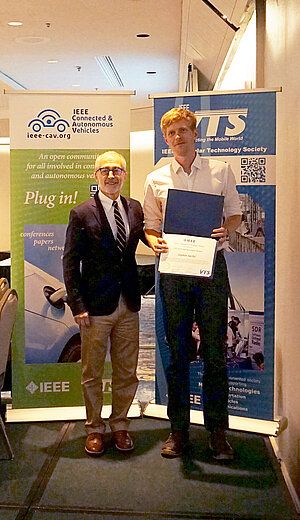November 5, 2019

Dr.-Ing. Stephan Jaeckel, Project Manager in the Wireless Communications and Networks Department at the Fraunhofer Heinrich Hertz Institute HHI, has received the "Best Paper Award" alongside his colleagues and co-authors at the IEEE 90th Vehicular Technology Conference 2019 (VTC2019-Fall) in Honolulu, Hawaii, USA.
The winning work is titled: "Industrial Indoor Measurements from 2-6 GHz for the 3GPP-NR and QuaDRiGa Channel Model". In addition to Stephan Jaeckel, Fraunhofer HHI employees Nick Turay, Leszek Raschkowski and Lars Thiele were involved in the project. In addition, Frank Burkhardt, Prasanth Karunakaran and Thomas Heyn (all: Fraunhofer Institute for Integrated Circuits IIS) as well as Risto Vuohtoniemi, Marko Sonkki and Veikko Hovinen (all: Centre for Wireless Communications, Oulu, Finland) are co-authors. The work examines the 3GPP NR model and the QuaDRiGa model with respect to currently missing dispersion parameters for the industrial indoor scenario.
Providing reliable low latency wireless links for advanced manufacturing and processing systems is a vision of Industry 4.0. Developing, testing and rating requires accurate models of the radio propagation channel. The current 3rd generation partnership project (3GPP) new radio (NR) model as well as the quasi deterministic radio channel generator (QuaDRiGa) lack the propagation parameters for the industrial indoor scenario. To close this gap, measurements were conducted at 2.37 GHz and 5.4 GHz at operational Siemens premises in Nuremberg, Germany. Furthermore, the campaign was planned to allow the test and parameterization of new features of the QuaDRiGa channel model such as support for device-to-device (D2D) radio links and spatial consistency. A total of 5.9 km measurement track was used to extract the statistical model parameters for line of sight (LOS) and Non-LOS propagation conditions. It was found that the metallic walls and objects in the halls create a rich scattering environment, where a large number of multipath components arrive at the receiver from all directions. This leads to a robust communication link, provided that the transceivers can handle the interference. The extracted parameters can be used in geometric-stochastic channel models such as QuaDRiGa to support simulation studies, both on link and system level.
Stephan Jaeckel has been working as a research associate in the Department of Wireless Communications and Networks at Fraunhofer HHI since December 2007. He is the lead developer of the QuaDRiGa channel model. His research interests include measurements and data analysis in heterogeneous multi-cell networks as well as channel modelling for terrestrial and satellite radio systems.